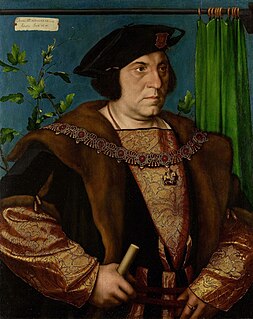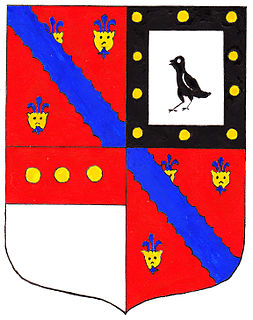Related Research Articles

Thomas Boleyn, Earl of Wiltshire, 1st Earl of Ormond, 1st Viscount RochfordKGKB, of Hever Castle in Kent, was an English diplomat and politician who was the father of Anne Boleyn, the second wife of King Henry VIII, and was thus the maternal grandfather of Queen Elizabeth I. By Henry VIII he was made a knight of the Garter in 1523 and was elevated to the peerage as Viscount Rochford in 1525 and in 1529 was further ennobled as Earl of Wiltshire and Earl of Ormond.

Manuel I, known as the Fortunate, was King of Portugal from 1495 to 1521. A member of the House of Aviz, Manuel was Duke of Beja and Viseu prior to succeeding his cousin, John II of Portugal, as monarch. Manuel ruled over a period of intensive expansion of the Portuguese Empire owing to the numerous Portuguese discoveries made during his reign. His sponsorship of Vasco da Gama led to the Portuguese discovery of the sea route to India in 1498, resulting in the creation of the Portuguese India Armadas, which guaranteed Portugal's monopoly on the spice trade. Manuel began the Portuguese colonization of the Americas and Portuguese India, and oversaw the establishment of a vast trade empire across Africa and Asia. He was also the first monarch to bear the title: By the Grace of God, King of Portugal and the Algarves, and the Sea from Both Sides of Africa, Lord of Guinea and the Conquest, Navigation and Commerce in Ethiopia, Arabia, Persia and India.

Richard Foxe was an English churchman, the founder of Corpus Christi College, Oxford. He was successively Bishop of Exeter, Bath and Wells, Durham, and Winchester, and became also Lord Privy Seal.

Thomas Wriothesley, 1st Earl of Southampton, KG was an English peer, secretary of state, Lord Chancellor and Lord High Admiral. A naturally skilled but unscrupulous and devious politician who changed with the times and personally tortured Anne Askew, Wriothesley served as a loyal instrument of King Henry VIII in the latter's break with the Catholic church. Richly rewarded with royal gains from the Dissolution of the Monasteries, he nevertheless prosecuted Calvinists and other dissident Protestants when political winds changed.
William Knight was the Secretary of State to Henry VIII of England, and Bishop of Bath and Wells.

Henry, Duke of Cornwall was the first living child of King Henry VIII of England and his first wife, Catherine of Aragon, and though his birth was celebrated as that of the heir apparent, he died within weeks. His death and Henry VIII's failure to produce another surviving male heir with Catherine led to succession and marriage crises that affected the relationship between the English church and Roman Catholicism, giving rise to the English Reformation.

John III was jure uxoris King of Navarre from 1484 until his death, as husband and co-ruler with Queen Catherine.

In common parlance, the wives of Henry VIII were the six queens consort wedded to Henry between 1509 and his death in 1547. In legal terms, King Henry VIII of England had only three wives, because three of his marriages were annulled by the Church of England. However, he was never granted an annulment by the Pope, as he desired, for Catherine of Aragon, his first wife. Annulments declare that a true marriage never took place, unlike a divorce, in which a married couple end their union. Along with his six wives, Henry took several mistresses.
Catherine, Queen of Navarre, reigned from 1483 until 1517. She was also Duchess of Gandia, Montblanc, and Peñafiel, Countess of Foix, Bigorre, and Ribagorza, and Viscountess of Béarn.

Agnes Howard was the second wife of Thomas Howard, 2nd Duke of Norfolk. Two of King Henry VIII's queens were her step-granddaughters, Anne Boleyn and Catherine Howard. Catherine Howard was placed in the Dowager Duchess's care after her mother's death.
Sir William Boleyn of Blickling Hall in Norfolk and Hever Castle in Kent, was a wealthy and powerful landowner who served as Sheriff of Kent in 1489 and as Sheriff of Norfolk and Suffolk in 1500. He was the father of Thomas Boleyn, 1st Earl of Wiltshire, whose daughter was Queen Anne Boleyn, the second wife of King Henry VIII.
Sir Edward Bayntun, of Bromham, Wiltshire, was a gentleman at the court of Henry VIII of England. He was vice-chamberlain to Anne Boleyn, the King's second wife, and was the brother-in-law of Queen Catherine Howard, Henry VIII's fifth wife.
Sir Thomas LeighorLegh (?1511-1545) was an English jurist and diplomat, who played a key role as agent of Henry VIII and Thomas Cromwell in the Dissolution of the Monasteries.

Sir Henry Guildford, KG (1489–1532) was an English courtier of the reign of King Henry VIII, master of the horse and comptroller of the royal household.
Sir Geoffrey Pole of Lordington, Sussex was an English knight who supported the Catholic Church in England and Wales when Henry VIII of England was establishing the alternative Church of England with himself as leader.

Sir Richard Weston (1465–1541), KB, of Sutton Place in the parish of Guildford in Surrey, was a courtier and diplomat who served as Governor of Guernsey, Treasurer of Calais and Under-Treasurer of the Exchequer during the reign of King Henry VIII.
Don Pedro de Ayala also Pedro López Ayala was a 16th-century Spanish diplomat employed by Ferdinand II of Aragon and Isabella I of Castile at the courts of James IV of Scotland and Henry VII of England. His mission to Scotland was concerned with the King's marriage and the international crisis caused by the pretender Perkin Warbeck. In his later career he supported Catherine of Aragon in England but was involved in a decade of rivalry with the resident Spanish ambassador in London. Ayala was a Papal prothonotary, Archdeacon of London, and Bishop of the Canary Islands.

Sir William Denys (1470–1533) of Dyrham, Gloucestershire, was a courtier of King Henry VIII and High Sheriff of Gloucestershire in 1518 and 1526.

Sir Humphrey Style, 1st Baronet of Beckenham, Kent was a courtier to kings James I and Charles I of England.
Sir Humphrey Style of Langley Park, Beckenham Kent was an Esquire of the Body of Henry VIII of England and a sheriff of Kent.
References
- ↑ p.162, Robert Hutchinson, 2012, Young Henry
- ↑ Garrett Mattingly (1 January 2009). Renaissance Diplomacy. Cosimo, Inc. p. 159. ISBN 978-1-60520-470-3.
- ↑ Prerogative Court of Canterbury
- ↑ Letters and Papers, Foreign and Domestic, of the Reign of Henry VIII.: Preserved in the Public Record Office, the British Museum and Elsewhere. 1519 - 1523. H.M. Stationery Office. 1867.
- ↑ Anne F. Sutton (2010), 'London mercers from Suffolk c. 1200–1570' PSIA, Volume XLII, part 2: http://suffolkinstitute.pdfsrv.co.uk